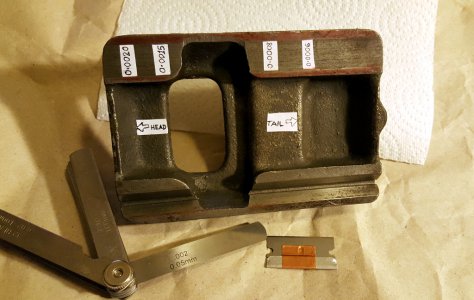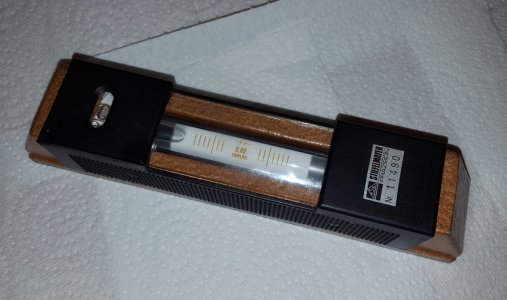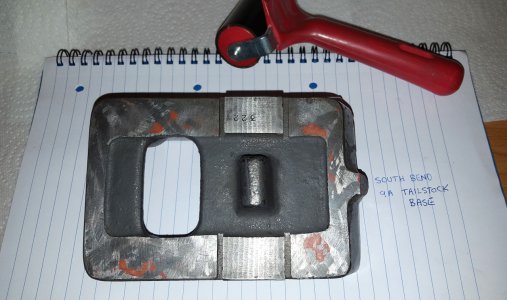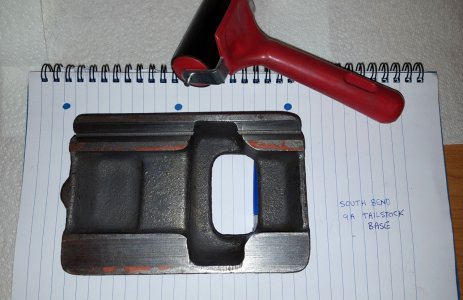- Joined
- May 27, 2016
- Messages
- 3,469
An evaluation - if you like.
This is the lower part of my SB9A tailstock after a partial cleanup, and an admittedly casual attempt at checking the wear. I used a red highlighter to try and show up the "unworn" parts. (Red highlighters don't work as well on cast steel as they do on paper)!
I used a single edge blade set to straddle the worn bits, and tried to stick feeler gauge shims underneath. I know that there are tailstocks around still doing quite accurate work, having wear somewhat worse than this, but I post it anyway. This is just about making the SB9A as nice as I can within reason, piece by piece, done as and when I can get to it. This machine has to get repairs, some new parts, alignment, a paint job, wicks, drive belt, etc.

The worn parts have score marks, no doubt from chips or dirt getting under there. There is a similar wear ridge, about 1mm wide, on only at the very edge of the vee nearest the feeler gauge where I tried to mark it in red. It progressively thins out, and disappears entirely by the right half of the vee. I guess if there was wear on where the flat way rubbed, then there would be similar wear in the vees, but we can only see one side of the vee wear, because the "other" ridge does not form, it being in the relief slot.
Such as it is, I value any comment. I don't know what is "OK" or "seriously messed up", nor anything in between. I don't know what folk would do to help the state of it somewhat - if i needs it at all.
I can anticipate that if any attempt is made to get the sliding face flat, then it involves also taking care of the vees, to maintain the relationship between the flat, and the prism ways. Of course, if there are any trick tips for improvements - then do tell..
This is the lower part of my SB9A tailstock after a partial cleanup, and an admittedly casual attempt at checking the wear. I used a red highlighter to try and show up the "unworn" parts. (Red highlighters don't work as well on cast steel as they do on paper)!
I used a single edge blade set to straddle the worn bits, and tried to stick feeler gauge shims underneath. I know that there are tailstocks around still doing quite accurate work, having wear somewhat worse than this, but I post it anyway. This is just about making the SB9A as nice as I can within reason, piece by piece, done as and when I can get to it. This machine has to get repairs, some new parts, alignment, a paint job, wicks, drive belt, etc.

The worn parts have score marks, no doubt from chips or dirt getting under there. There is a similar wear ridge, about 1mm wide, on only at the very edge of the vee nearest the feeler gauge where I tried to mark it in red. It progressively thins out, and disappears entirely by the right half of the vee. I guess if there was wear on where the flat way rubbed, then there would be similar wear in the vees, but we can only see one side of the vee wear, because the "other" ridge does not form, it being in the relief slot.
Such as it is, I value any comment. I don't know what is "OK" or "seriously messed up", nor anything in between. I don't know what folk would do to help the state of it somewhat - if i needs it at all.
I can anticipate that if any attempt is made to get the sliding face flat, then it involves also taking care of the vees, to maintain the relationship between the flat, and the prism ways. Of course, if there are any trick tips for improvements - then do tell..




